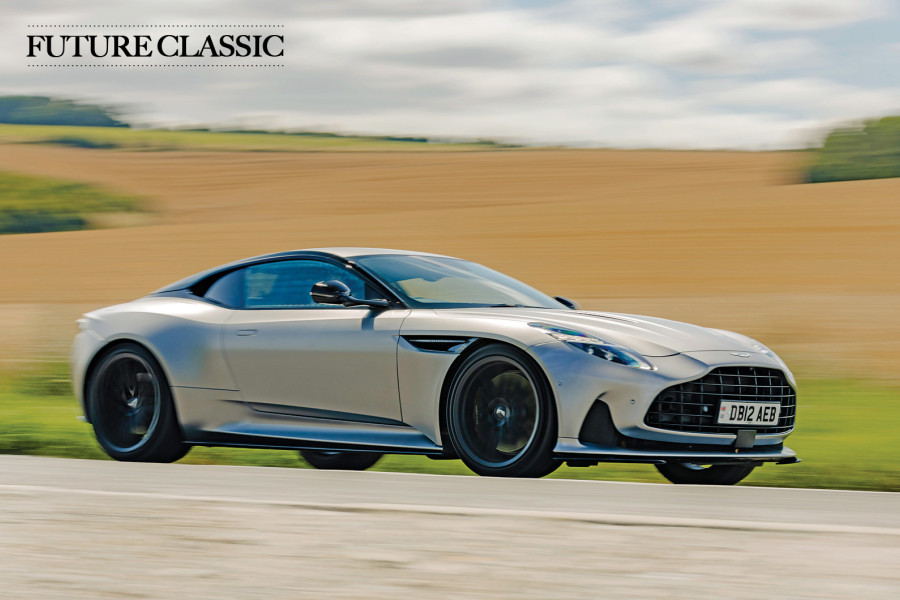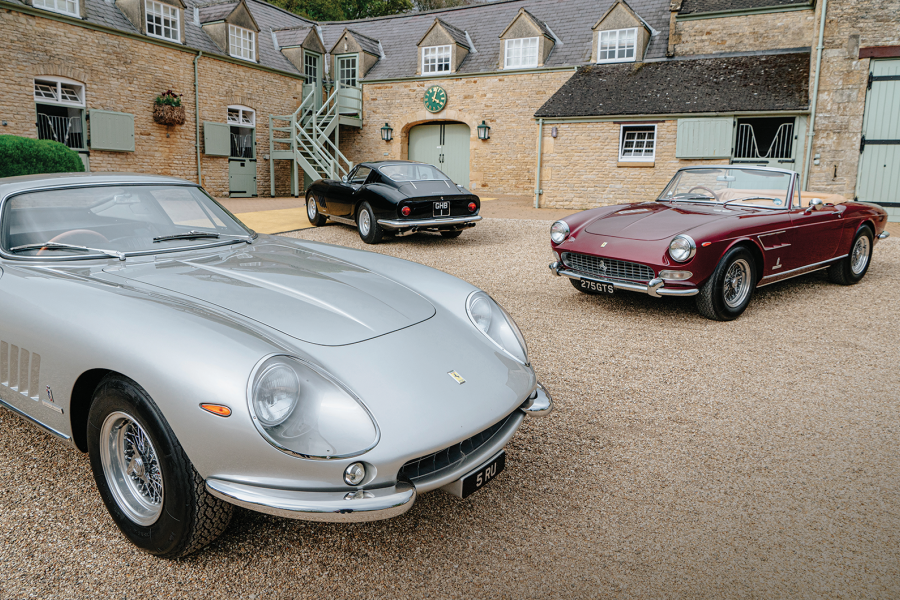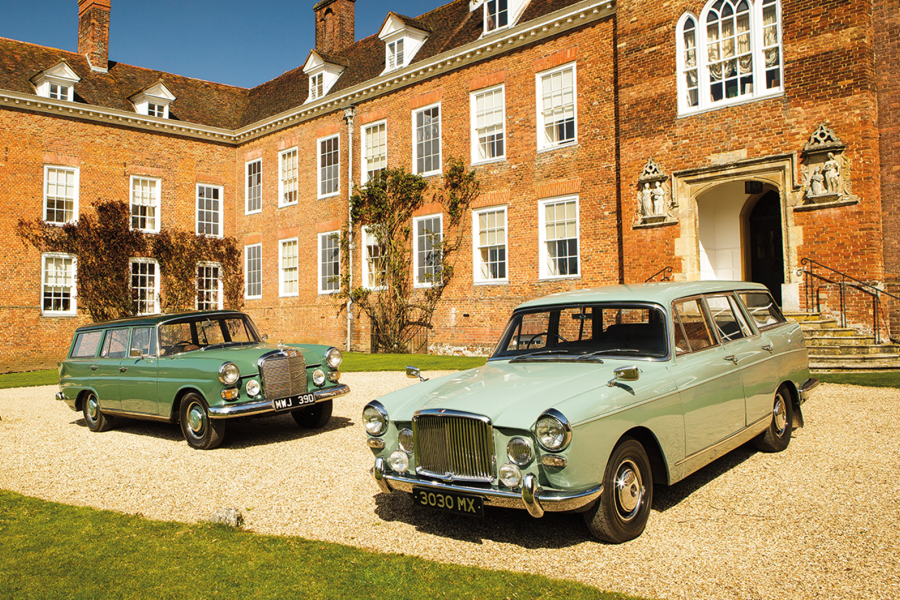The clutch is similarly weighty, but the ZF five-speed gearbox shifts so sweetly and precisely that it must have been a revelation compared to the rather obstreperous four-speed David Brown unit it replaced.
The Aston Martin gives you an excellent sense of what’s going on underneath, its more traditional set-up of double wishbones up front and a well-located live rear axle inspiring instant familiarity.
The Tadek Marek-designed 4-litre twin-cam ‘six’, too, is full of surprises. Initial impressions are of a smooth and civilised unit, but if you push your foot to the floor, it takes a deep breath and past 3000rpm offers a knockout punch – enough to keep even the flyweight Ferrari in its sights.
Taking the Mercedes-Benz 300SL (left), Ferrari 275GTB (middle) and Aston Martin DB5 to Zandvoort for a dream track day
Around Zandvoort, the DB5 communicates clearly what the suspension and tyres are doing and doesn’t overreact to fast direction changes.
The steering is sweetly sensitive and the servo-assisted Girling disc brakes have the instant bite you miss in the Benz.
This is the consummate long-distance GT yet, alongside the Mercedes, the DB5 feels downright frisky: it’s agile, reacts quickly and can be driven with more precision – and less fear of repercussions – than the more complex German.
The 300SL demands the most concentration, but offers huge rewards, too
It would be churlish to argue that the Ferrari 275GTB is anything other than a fabulous machine, but to my eyes it’s the least attractive of our trio.
It’s often referred to as Pininfarina’s masterpiece, but that does a disservice to the 250GT SWB, GTO and Lusso that came before it, with the 275’s muscular and slightly too-tall sides giving a certain clumsiness that makes its roof look low and its wheels appear too small.
It’s possible that Enzo Ferrari was not completely satisfied with the 275GTB, either, because production was halted after four years.
The Mercedes-Benz 300SL Gullwing has a muscular soundtrack
When Il Commendatore saw an – unsolicited – design for a potential successor, he immediately gave the go-ahead to develop it for production.
That car became the 365GTB/4, better known as the Daytona, and its shape came from the pen of Leonardo Fioravanti, then working for Pininfarina, who had embarked on the design as an evening project after being unhappy with the appearance of the 275GTB.
Nevertheless, it remains an imposing and impressive sight as it looms in your mirrors coming out of Zandvoort’s twists and turns, like a hungry predator baring its teeth as it slowly but surely reels you in.
‘The Ferrari is an imposing sight as it looms in your mirrors through the turns, a hungry predator baring its teeth as it slowly but surely reels you in’
The snug interior of the Ferrari comes as a bit of a disappointment after the 300SL and DB5: simple and functional, it gives the appearance of an expensive Fiat rather than a glamorous super-GT.
The Veglia instruments make some impressive promises, however: the speedometer reaches a heady 300kph (186mph) and the rev counter is redlined at 7600rpm.
That focus on performance continues as you settle into bucket seats that give more support than their rivals, and look out over the long bonnet that stretches away above the elegant, wood-rimmed steering wheel with its evocative yellow-and-black logo.
Behind your back there is only a parcel shelf, and a large proportion of the boot is occupied by the spare wheel and tool roll.
Through the curves of the Zandvoort circuit, the 275GTB’s thoroughbred nature is immediately apparent
The real magic of the 275GTB is to be found under the skin, because this was the first series-produced roadgoing Ferrari with independent rear suspension.
It is also the only car here to have a transaxle transmission to improve weight distribution, counteracting the heft of the 3.3-litre V12 up front.
Fed by three twin-choke Weber carbs, it produces a fraction less power than the Aston, at 276bhp, and the unusually oversquare unit can’t even better the Mercedes in its torque output: this is an engine that thrives on revs.
To improve performance, in 1966 Maranello introduced the 275GTB/4 with quad overhead camshafts, six Webers and an extra 20bhp. Even in two-cam form this is a spectacular engine.
The twists and turns of Zandvoort expose the different qualities of the DB5 (right), 300SL (middle) and 275GTB
Once the warm-blooded and symphonic sound of the V12 hits your ears, you know you’re in for something special.
Moving the gearlever through the classic open gate is a bit stiff, confirming that you are driving a large-calibre machine, but the pedals are perfectly positioned for heel-and-toe shifts and the engine’s flexibility belies those on-paper figures.
It calmly accepts low revs when necessary, but always prefers to behave like the Italian thoroughbred it is in heart and soul.
Bury the throttle and the V12 will treat you to one of the finest automotive soundtracks, accompanied by a shove in the back that keeps on coming all the way to the redline.
‘The Aston Martin gives you an excellent sense of what’s going on underneath, its more traditional set-up inspiring instant familiarity’
The steering is unexpectedly low-geared, but the Ferrari turns in eagerly and with real precision.
Its independent rear end and Michelin XWXs will accept you piling on the power out of the faster bends of the Zandvoort track – this is a car that immediately gives you the confidence to drive very quickly.
On the road, there is little to separate the DB5 and the 275: the Ferrari is a car born to pound the autostradas of northern Italy or the wide, open country roads of the Mille Miglia.
But on the track the GTB soon shows itself to be far superior when the going gets twisty, its significant weight advantage and higher rev range giving you more flexibility.
The talented Aston Martin DB5 flows skilfully with each winding ribbon of asphalt
Returning to our hypothetical wealthy collector and their buying dilemma, which of this trio to recommend?
Despite its lower weight, the Italian car feels heavier and less fleet of foot than the DB5.
The Aston Martin comes from an era when Britain was not yet criss-crossed by today’s web of motorways, when long distances were covered on two-lane roads through a wide variety of landscapes. This kind of winding asphalt ribbon remains the perfect place to demonstrate its talent for speed.
The smooth DB5 delivers a knockout punch past 3000rpm
In contrast, the Ferrari feels like a more brutal machine, one that sees the road as a reluctant opponent which must be forced into submission.
That the Mercedes is outgunned on the race track comes as no surprise, yet it deserves to stand shoulder-to-shoulder with its younger rivals – after all, this was what Road & Track called: ‘The sports car of the future.’
It’s also a machine whose enormous personality offers the greatest sense of theatre from behind the wheel, and one whose shape is impossible to take your eyes off.
‘That the 300SL [left] is outgunned comes as no surprise, yet it deserves to stand shoulder-to-shoulder with its younger rivals’
There is no fault on the 300SL; no line, no curve or surface could have been drawn better.
It demands the utmost commitment and skill from its driver, but rewards with enormous satisfaction.
All three are stars, but it’s the three-pointed star that shines brightest.
Images: Luuk van Kaathoven/Onno Blaauw
Factfiles
Aston Martin DB5
- Sold/number built 1963-’65/1059 (including 123 convertibles)
- Construction steel platform chassis, aluminium body over tubular steel frame
- Engine all-alloy, dohc 3995cc straight-six with triple SU carburettors (Webers on Vantage models)
- Max power 282bhp @ 5500rpm
- Max torque 280lb ft @ 4500rpm
- Transmission ZF five-speed manual, RWD
- Suspension: front independent, by double wishbones, telescopic dampers, anti-roll bar rear live axle, trailing arms, Watt linkage, adjustable lever-arm dampers; coil springs f/r
- Steering rack and pinion
- Brakes discs, with servo
- Length 15ft (4570mm)
- Width 5ft 6in (1676mm)
- Height 4ft 5in (1346mm)
- Wheelbase 8ft 2in (2489mm)
- Weight 3236lb (1468kg)
- 0-60mph 8.1 secs
- Top speed 142mph
- Mpg 14.7
- Price new £4048
- Price now £500,000-1m*
Mercedes-Benz 300SL
- Sold/number built 1954-’57/1400
- Construction tubular steel spaceframe, steel and aluminium body
- Engine iron-block, alloy-head, sohc 2996cc 45º slant-six, Bosch mechanical fuel injection
- Max power 240bhp @ 6100rpm
- Max torque 217lb ft @ 4800rpm
- Transmission four-speed manual, RWD
- Suspension independent, at front by double wishbones, anti-roll bar rear swing axles; coil springs, telescopic dampers f/r
- Steering recirculating ball
- Brakes Alfin drums, with servo
- Length 15ft (4572mm)
- Width 5ft 10½in (1791mm)
- Height 4ft 3¼in (1302mm)
- Wheelbase 7ft 10½in (2400mm)
- Weight 2855lb (1295kg)
- 0-60mph 8.8 secs
- Top speed 154mph
- Mpg 21
- Price new £4393
- Price now £1-1.5m*
Ferrari 275GTB
- Sold/number built 1964-’66/c450
- Construction steel body, tubular steel chassis
- Engine all-aluminium, sohc-per-bank 3285cc 60º V12, three twin-choke Weber carburettors
- Max power 276bhp @ 7600rpm
- Max torque 217Ib ft @ 5000rpm
- Transmission five-speed manual transaxle, RWD
- Suspension independent, by unequal-length wishbones, coil-over dampers, anti-roll bar f/r
- Steering worm and roller
- Brakes discs, with servo
- Length 14ft 2¼in (4325mm)
- Width 5ft 8in (1725mm)
- Height 4ft 1in (1245mm)
- Wheelbase 7ft 10½in (2398mm)
- Weight 2734lb (1240kg)
- 0-60mph 6 secs
- Top speed 160mph
- Mpg 12
- Price new £5590
- Price now £1.3-2m*
*Prices correct at date of original publication
READ MORE
Aston Martin DB2/4 Vignale: fitted out for a king
Ferrari 250GTE: Enzo’s roadgoing winner
The Mercedes-Benz 300SL Gullwing that came in from the cold
Better by the dozen: Lamborghini Murciélago vs Aston Martin Vanquish S vs Ferrari 575M





































